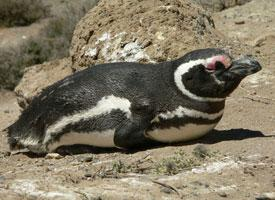
Súlyok és méretek
| Marmagasság | 60-tól 70-ig cm |
|---|---|
| Súly | 3,5-tól 5-ig kg |
Biológiai adatok
| Élettartam | 25 r |
|---|
Veszélyeztetettség
| Veszélyeztetett |
Állatleírás
The Magellanic penguin (Spheniscus magellanicus) is a captivating species of bird, native to the cooler regions of South America, particularly known for its distinctive habitat along the coasts of Argentina, Chile, and the Falkland Islands, with some migrating as far as Brazil during the non-breeding season. This species belongs to the Spheniscidae family, which encompasses all penguin species, a group of flightless birds uniquely adapted to marine life.Characterized by its medium size, an adult Magellanic penguin typically stands about 24 to 30 inches tall and weighs approximately 8 to 14 pounds, making it neither the largest nor the smallest among its penguin relatives. The bird's plumage is predominantly black and white, a common color scheme among penguins that serves as camouflage while swimming. The back and the outer parts of the flippers are black, creating an effective backdrop against the ocean's depths when viewed from above, while the front is primarily white, blending with the bright surface when seen from below. This counter-shading aids in protection against predators such as sea lions, orcas, and leopard seals.
One of the most striking features of the Magellanic penguin is the two black bands across the chest. The first band is a broad stripe running in a horseshoe shape from each shoulder down across the breast, while the second, thinner band is situated lower on the belly. These bands distinguish it from closely related species, such as the Humboldt penguin, with which it shares portions of its range. Additionally, Magellanic penguins have a distinctive white band that outlines the face, extending from the eye, around the ear, and under the chin.
Magellanic penguins are highly social birds, forming large colonies for breeding, which can number in the hundreds of thousands. The breeding season begins in September and lasts until February, during which time pairs demonstrate strong fidelity to their nesting sites, returning to the same location year after year. Nests are typically built in burrows dug into the ground, which helps protect eggs and chicks from predators and extreme temperatures. A typical clutch consists of two eggs, which are incubated by both parents in shifts for about 40 days.
Diet-wise, these penguins are adept hunters, feeding primarily on small fish, squid, and krill. They are excellent swimmers, using their flippers for propulsion and their feet and tail for steering. Magellanic penguins can dive to depths of over 250 feet in search of food, though most of their foraging occurs much closer to the surface.
Despite their adaptability, Magellanic penguins face threats from oil spills, pollution, and climate change, which impact their food sources and breeding habitats. They are also vulnerable to overfishing, which reduces their primary food sources, and to bycatch, where they are accidentally caught in fishing nets. Conservation efforts are in place to protect their habitats, monitor populations, and mitigate threats from human activities.
In summary, the Magellanic penguin is a remarkable species, showcasing a unique blend of social behavior, physical adaptations, and environmental challenges. Its life in the southern reaches of the Americas offers a glimpse into the complex interplay between marine species and their habitats, underscoring the importance of ongoing conservation efforts to ensure the survival of these distinctive birds.
Hasonló állatok
Új állatfotók
Top 10 állat
- Dolphin gull (Leucophaeus scoresbii)
- Diana monkey (Cercopithecus diana)
- Moustached guenon (Cercopithecus cephus)
- Stone loach (Barbatula barbatula)
- Greek tortoise (Testudo graeca)
- Galápagos tortoise (Geochelone nigra complex)
- Japanese macaque (Macaca fuscata)
- Russian tortoise (Testudo horsfieldii)
- Common flying dragon (Draco volans)
- Galápagos penguin (Spheniscus mendiculus)


